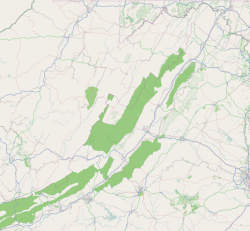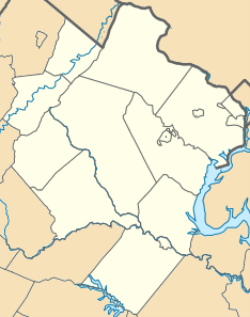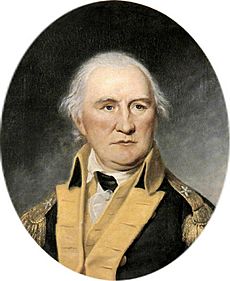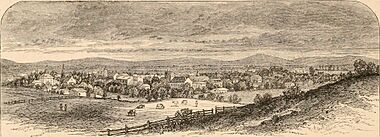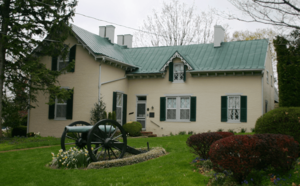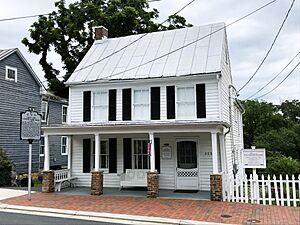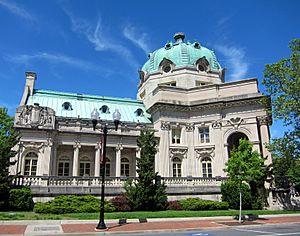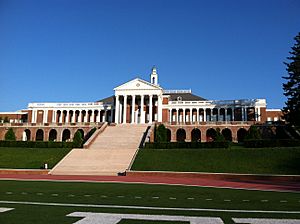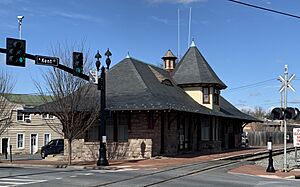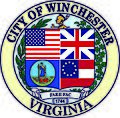Winchester, Virginia facts for kids
Quick facts for kids
Winchester, Virginia
|
||
|---|---|---|
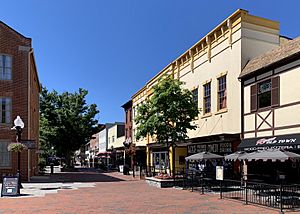
Loudoun Street Mall in Winchester in July 2020
|
||
|
||
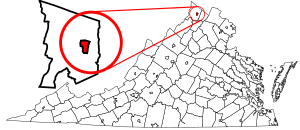
Location of Winchester in Virginia
|
||
| Country | United States | |
| State | Virginia | |
| County | None (Independent city) | |
| Founded | 1744 | |
| Area | ||
| • Total | 9.21 sq mi (23.86 km2) | |
| • Land | 9.19 sq mi (23.81 km2) | |
| • Water | 0.02 sq mi (0.05 km2) | |
| Elevation | 725 ft (221 m) | |
| Population
(2020)
|
||
| • Total | 28,120 | |
| • Density | 3,053.2/sq mi (1,178.5/km2) | |
| Time zone | UTC−5 (EST) | |
| • Summer (DST) | UTC−4 (EDT) | |
| ZIP Code |
22601
|
|
| Area code(s) | 540 | |
| FIPS code | 51-86720 | |
| GNIS feature ID | 1498552 | |
Winchester is a city located in the northwestern part of Virginia, United States. It is an independent city, meaning it is not part of any county. However, it is the main city for Frederick County.
In 2020, about 28,120 people lived in Winchester. It is the main city of the Winchester metropolitan area, which has over 145,000 people. This area even reaches into West Virginia. Winchester is also home to Shenandoah University and the Museum of the Shenandoah Valley.
Contents
Exploring Winchester's Past
Early Native American Life
For thousands of years before Europeans arrived, Indigenous peoples lived along the rivers in what is now Virginia. They had rich cultures. The Shenandoah Valley was a special hunting ground. By the 1600s, Iroquoian-speaking groups, like the Senedo and Sherando, mostly controlled this area.
Later, the Algonquian-speaking Shawnee people also wanted to use these hunting grounds. Explorers in 1671 saw the Shawnee fighting the Iroquoians. During the Beaver Wars, the powerful Iroquois Confederacy from New York took control over many tribes in the frontier region.
When European settlers came to the Shenandoah Valley around 1729, the Shawnee were the main group living near where Winchester is today. During the first ten years of white settlement, the valley was also a battleground. The Seneca and Lenape tribes from the north fought their old enemies, the Siouan Catawba from the Carolinas.
The Iroquois Six Nations (which included the Tuscarora people by 1722) finally gave up their claim to the Shenandoah Valley in 1744. This happened at the Treaty of Lancaster. This treaty also allowed colonists to use the Indian Road, which later became known as the Great Wagon Road.
The father of the Shawnee chief Cornstalk had his court near today's Cross Junction, Virginia until 1754. In 1753, before the French and Indian War, messengers invited the Shawnee to leave the Valley. They moved west across the Alleghenies the next year. The Shawnee lived in the Ohio Country for some years. Later, the U.S. government forced them to move to Indian Territory in the 1830s.
European Settlers Arrive
French explorers might have entered the valley as early as 1606. Samuel de Champlain even drew a rough map in 1632. The first confirmed exploration of the northern valley was by John Lederer in 1670. Later, in 1705, Louise Michel, and in 1716, Governor Alexander Spotswood, made more detailed maps.
In the late 1720s, Governor William Gooch encouraged people to settle here by giving out large pieces of land. Robert "King" Carter received 200,000 acres (809 km²). This led to many settlers from Pennsylvania and New York moving in. These new settlers included Quakers, German, and Scots-Irish families. Many of them were new immigrants.
Winchester began to be settled around 1729. Quakers like Abraham Hollingsworth traveled south along the Great Wagon Road from Pennsylvania. They started building homes on old Shawnee camping grounds. It is said that the Quakers bought land from the native people, who did not bother these settlements. The first German settler, Jost Hite, arrived in 1732 with ten other families.
Even though Virginia was an Anglican colony, Governor Gooch allowed different religions. Many religious families came because of the land grants. They often received 50-acre (202,343 m²) plots. Because of this, Winchester became home to some of the oldest Presbyterian, Quaker, Lutheran, and Anglican churches in the valley.
A legal dispute started in 1735. Lord Fairfax came to Virginia to claim his land grant. This grant, from King Charles II, included "all the land in Virginia between the Rappahannock and the Potomac rivers." This overlapped with Frederick County. It took time to sort out who owned which land among the early settlers.
How Winchester Was Founded
By 1738, these settlements were known as Frederick Town. Frederick County was created from Orange County. The first local government was formed, including a County Court. Colonel James Wood, who came from Winchester, England, was the first court clerk. He was also a surveyor for Orange County.
Colonel Wood built his home, Glen Burnie homestead, around 1737. This building might have been used for early government meetings. In 1744, Wood planned out 26 half-acre (2,000 m²) lots. The County Court met for the first time on November 11, 1743, with James Wood serving until 1760. Lord Fairfax, knowing that owning land was important, built a home here in 1748.
In February 1752, the Virginia House of Burgesses gave Frederick Town its city charter. It was renamed 'Winchester' after Colonel Wood's hometown in England. In 1754, Abraham Hollingsworth built a house called Abram's Delight. This house was also the first local Quaker meeting house.
George Washington spent a lot of his younger life in Winchester. He helped survey the Fairfax land grant for Lord Fairfax and also worked for Colonel Wood. In 1758, Wood added 158 more lots to the west side of town. In 1759, Lord Fairfax added 173 more lots to the south and east.
Winchester During the French and Indian War
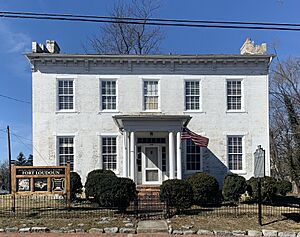
In 1755, General Edward Braddock's army marched through this area on their way to Fort Duquesne. George Washington, who knew the area well from his surveying work, went with General Braddock. Daniel Morgan, a local resident, joined Braddock's army as a wagon driver.
In 1756, on land given by James Wood, Colonel George Washington designed and started building Fort Loudoun. This fort covered about 0.955 acres (3,860 m²) in downtown Winchester. Fort Loudoun was used and had cannons until the American Revolutionary War began.
During this time, a jail was built in Winchester. It sometimes held Quakers from different parts of Virginia. They were jailed because they protested the French and Indian War and refused to pay taxes to the Anglican church. Virginia was an Anglican colony and did not easily accept people who were against war. This strong Quaker belief in peace, against Virginia's support for the war, caused the Quaker population to shrink over time.
In 1758, at age 26, Colonel George Washington was chosen to represent Frederick County in the House of Burgesses. Daniel Morgan later served as a ranger, protecting Virginia's borders from Native American raids. He returned to Winchester in 1759. After the war, from 1763 to 1774, Daniel Morgan defended Virginia against Pontiac's Conspiracy and Shawnee Indians.
Winchester in the Revolutionary War
During the Revolutionary War, the Virginia House of Burgesses asked Daniel Morgan, a local resident and veteran of the French and Indian War, to gather a group of soldiers. These soldiers would help General George Washington. Morgan led 96 men, called "Morgan's Sharpshooters," from Winchester on July 14, 1775. They marched to Boston in 21 days.
Morgan, Wood, and others also helped hold captured prisoners of war, especially Hessian soldiers. These Hessian soldiers were known to walk to a high ridge north and west of town. There, they could buy and eat apple pies made by the Quakers. This ridge became known as Apple Pie Ridge. The road leading north from town was renamed Apple Pie Ridge Road. Local farmers did good business feeding the Virginia Militia and the new American army.
After the war, Winchester's first newspapers, The Gazette and The Centinel, were started. Daniel Morgan continued to serve the public. He was elected to the U.S. House of Representatives for one term (1797–1799).
Winchester During the Civil War
Winchester and the areas around it saw many battles during the American Civil War. Both the Confederate and Union armies wanted to control this part of the Shenandoah Valley. Seven major battlefields are in the original Frederick County.
Battles within Winchester city:
- The First Battle of Kernstown, March 23, 1862
- The First Battle of Winchester, May 25, 1862
- The Second Battle of Winchester, June 13–15, 1863
- The Second Battle of Kernstown, July 24, 1864
- The Third Battle of Winchester, September 19, 1864
Battles near Winchester city:
- The Battle of Cool Spring at Snicker's Gap, July 17–18, 1864
- The Battle of Berryville, September 3–4, 1864
- The Battle of Belle Grove (or Cedar Creek), October 19, 1864
Winchester was a very important location for the Confederate States Army during the war. It was a key goal for Gen Joseph E. Johnston and Col Thomas J. "Stonewall" Jackson in defending the Shenandoah Valley in 1861. It was also important in Jackson's Valley Campaign of 1862, the Gettysburg Campaign of 1863, and the Valley Campaigns of 1864.
Historians say that Winchester changed hands as many as 72 times during the war. It even changed hands 13 times in one day! Battles sometimes happened right on Main Street. Union General Sheridan and Stonewall Jackson had their headquarters just one block apart at times.
Winchester was a starting point for major Confederate invasions into the Northern United States. These attacks sometimes threatened Washington, D.C. The town was a central spot for troops raiding the Baltimore and Ohio Railroad, Chesapeake and Ohio Canal, and telegraph lines. For example, in 1861, Stonewall Jackson took 56 locomotives and over 300 railroad cars. He also removed miles of track from the B&O Railroad. This attack shut down the B&O's main line for ten months. Much of the work to move this equipment by horse and carriage was done in Winchester.
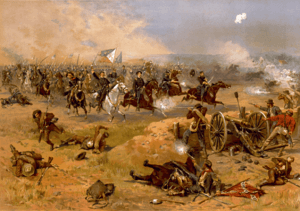
During the war, the Union Army occupied Winchester four times. Major General Nathaniel Banks occupied it from March to May 12–25, 1862, and again from June 4 to September 2, 1862. Major General Robert Milroy occupied it from December 24, 1862, to June 15, 1863. Major General Philip Sheridan occupied it from September 19, 1864, to February 27, 1865. Major General Winfield Scott Hancock occupied it from February 27, 1865, to June 27, 1865.
Major General Sheridan led raids up the valley from Winchester. His forces destroyed many barns filled with grain and tools, and many mills filled with wheat and flour. They also took livestock. This was done to reduce the area's ability to supply the Confederates.
Many local men served in the Confederate Army. Hunter McGuire was the Chief Surgeon for "Jackson's" Corps. He helped create rules for how medical doctors should be treated during war. Winchester was a major center for Confederate medical care. This was especially true after the Battle of Sharpsburg in 1862 and the Battle of Gettysburg in 1863. Future U.S. presidents McKinley and Hayes fought in battles at Winchester. They were officers in the Union IX Corps.
After the war, the United States kept a military presence in Winchester and other parts of the South during Reconstruction. Winchester was part of the First Military District, led by Major General John Schofield. This period lasted until January 26, 1870.
Winchester in the 20th Century
Winchester was the first city south of the Potomac River to have electric light. This happened in 1917. The Winchester and Western Railroad connected Winchester to Rock Enon Springs. This made it much faster to move people and supplies to the resort, which is now Camp Rock Enon.
Winchester hosts a bi-annual competition called N-SSA. This event keeps the tradition of Civil War era firearms alive. A three-block part of downtown Loudoun Street was closed to cars in the 1970s. It is now a popular area for walking, with many shops and cafes. The street was repaved with brick and improved in 2013. The Apple Blossom Mall opened in 1982.
In 1983, a large pile of over seven million old tires in the area caught fire. It burned for nine months. This caused a lot of pollution. The area was cleaned up as a Superfund project between 1983 and 2002.
Winchester's Geography and Climate
Winchester is located at 39°10′41″N 78°10′01″W / 39.178°N 78.167°W.
The United States Census Bureau says the city covers about 9.3 square miles (24 km²). Almost all of this area is land.
The city is in the Shenandoah Valley, between the Blue Ridge Mountains and the Allegheny Mountains. It is about 15 miles (24 km) north-northeast of Massanutten Mountain. I-81 goes through the city. Also, US 50, US 522, US 17, and SR 7 end in the city.
Winchester is about 75 miles (121 km) west of Washington, D.C. It is 24 miles (39 km) south of Martinsburg, West Virginia. It is also 25 miles (40 km) north of Front Royal.
Winchester's Climate
The climate in Winchester has hot, humid summers. Winters are usually mild to cool. According to the Köppen Climate Classification system, Winchester has a humid continental climate or a humid subtropical climate. This is shown as "Cfa" on climate maps. Winchester is one of the few cities in Virginia with a humid continental climate. The hardiness zone is 6b/7a.
| Climate data for Winchester, Virginia (1991–2020 normals, extremes 1912–present) | |||||||||||||
|---|---|---|---|---|---|---|---|---|---|---|---|---|---|
| Month | Jan | Feb | Mar | Apr | May | Jun | Jul | Aug | Sep | Oct | Nov | Dec | Year |
| Record high °F (°C) | 80 (27) |
81 (27) |
89 (32) |
98 (37) |
98 (37) |
104 (40) |
107 (42) |
107 (42) |
103 (39) |
99 (37) |
85 (29) |
80 (27) |
107 (42) |
| Mean daily maximum °F (°C) | 42.1 (5.6) |
45.4 (7.4) |
53.4 (11.9) |
65.6 (18.7) |
74.2 (23.4) |
82.6 (28.1) |
87.1 (30.6) |
85.5 (29.7) |
78.7 (25.9) |
67.4 (19.7) |
56.0 (13.3) |
45.7 (7.6) |
65.3 (18.5) |
| Daily mean °F (°C) | 31.6 (−0.2) |
34.0 (1.1) |
41.1 (5.1) |
52.0 (11.1) |
61.6 (16.4) |
70.3 (21.3) |
75.0 (23.9) |
73.2 (22.9) |
66.1 (18.9) |
54.4 (12.4) |
44.0 (6.7) |
35.4 (1.9) |
53.2 (11.8) |
| Mean daily minimum °F (°C) | 21.2 (−6.0) |
22.7 (−5.2) |
28.8 (−1.8) |
38.4 (3.6) |
48.9 (9.4) |
58.0 (14.4) |
62.8 (17.1) |
60.9 (16.1) |
53.5 (11.9) |
41.4 (5.2) |
32.0 (0.0) |
25.1 (−3.8) |
41.1 (5.1) |
| Record low °F (°C) | −18 (−28) |
−16 (−27) |
−6 (−21) |
12 (−11) |
28 (−2) |
36 (2) |
42 (6) |
36 (2) |
30 (−1) |
16 (−9) |
4 (−16) |
−6 (−21) |
−18 (−28) |
| Average precipitation inches (mm) | 2.48 (63) |
2.23 (57) |
3.43 (87) |
3.22 (82) |
3.94 (100) |
4.04 (103) |
3.82 (97) |
3.66 (93) |
4.39 (112) |
3.05 (77) |
2.89 (73) |
2.81 (71) |
39.96 (1,015) |
| Average precipitation days (≥ 0.01 in) | 8.8 | 7.9 | 9.8 | 12.6 | 13.5 | 12.1 | 11.8 | 10.8 | 10.1 | 9.2 | 7.6 | 8.6 | 122.8 |
| Source: NOAA | |||||||||||||
People and Population
| Historical population | |||
|---|---|---|---|
| Census | Pop. | %± | |
| 1840 | 3,454 | — | |
| 1850 | 3,857 | 11.7% | |
| 1860 | 4,392 | 13.9% | |
| 1870 | 4,477 | 1.9% | |
| 1880 | 4,958 | 10.7% | |
| 1890 | 5,196 | 4.8% | |
| 1900 | 5,161 | −0.7% | |
| 1910 | 5,864 | 13.6% | |
| 1920 | 6,883 | 17.4% | |
| 1930 | 10,855 | 57.7% | |
| 1940 | 12,095 | 11.4% | |
| 1950 | 13,841 | 14.4% | |
| 1960 | 15,110 | 9.2% | |
| 1970 | 14,643 | −3.1% | |
| 1980 | 20,217 | 38.1% | |
| 1990 | 21,947 | 8.6% | |
| 2000 | 23,585 | 7.5% | |
| 2010 | 26,203 | 11.1% | |
| 2020 | 28,120 | 7.3% | |
| U.S. Decennial Census 1790-1960 1900-1990 1990-2000 2010 2020 |
|||
Winchester's Population in 2020
| Race / Ethnicity | Pop 2010 | Pop 2020 | % 2010 | % 2020 |
|---|---|---|---|---|
| White alone (NH) | 18,085 | 17,623 | 69.02% | 62.67% |
| Black or African American alone (NH) | 2,783 | 2,800 | 10.62% | 9.96% |
| Native American or Alaska Native alone (NH) | 37 | 66 | 0.14% | 0.23% |
| Asian alone (NH) | 599 | 700 | 2.29% | 2.49% |
| Pacific Islander alone (NH) | 3 | 14 | 0.01% | 0.05% |
| Some Other Race alone (NH) | 57 | 135 | 0.22% | 0.48% |
| Mixed Race/Multi-Racial (NH) | 598 | 1,288 | 2.28% | 4.58% |
| Hispanic or Latino (any race) | 4,041 | 5,494 | 15.42% | 19.54% |
| Total | 26,203 | 28,120 | 100.00% | 100.00% |
Note: the US Census treats Hispanic/Latino as an ethnic category. This table excludes Latinos from the racial categories and assigns them to a separate category. Hispanics/Latinos can be of any race.
Winchester's Economy
Several companies have their main offices in Winchester. These include American Woodmark, Trex, and Rubbermaid Commercial Products. Also, some U.S. government agencies have offices here. These are the Federal Emergency Management Agency (FEMA), the Federal Bureau of Investigation (FBI), and the United States Army Corps of Engineers.
Here are the top employers in Winchester, based on a 2016 report:
| # | Employer | # of Employees |
|---|---|---|
| 1 | Valley Health | 1,000 and over |
| 2 | Rubbermaid Commercial Products | 500 - 999 |
| 3 | Winchester City Public Schools | 500 - 999 |
| 4 | Walmart | 500 - 999 |
| 5 | Shenandoah University | 500 - 999 |
| 6 | City of Winchester | 500 - 999 |
| 7 | Axiom Staffing Group | 500 - 999 |
| 8 | Martin's Food Markets | 500 - 999 |
| 9 | Trex | 250 - 499 |
| 10 | Kohl's | 250 - 499 |
Music Production in Winchester
Winchester was once home to Capitol Records' East Coast record pressing plant. In 1968, Capitol Records bought land in Winchester for this new plant. They also built houses and bought small businesses. Later, they built a tape production plant.
The Winchester plant started being built in 1968 and began making records in 1969. It first had 250 workers. This plant helped the other Capitol Records factories in Scranton, Pennsylvania, Jacksonville, Florida, and Los Angeles, California. In 1969, the Scranton plant slowly stopped making vinyl records, and the new Winchester plant took over.
Records made here include Talking Heads' Remain in Light, Dead Boys' Young, Loud and Snotty, and Yoko Ono's Fly (Yoko Ono album). In late 1987, Capitol Records announced it would stop making tapes in the U.S. and move production overseas. This led to the Winchester plant closing in early 1988, and over 500 employees lost their jobs.
Arts and Culture in Winchester
Historic Places to Visit
Winchester has many historic sites. Here are some of them:
| Site | Year Built | Address | Listed |
|---|---|---|---|
| Abram's Delight | 1754 | Parkview Street & Rouss Spring Road | 1973 |
| Douglas School | 1927 | 598 North Kent Street | 2000 |
| Fair Mount | 19th century | 311 Fairmont Avenue | 2004 |
| Glen Burnie | 1794 | 901 Amherst Street | 1979 |
| Handley Library | 1913 | Braddock & Piccadilly Streets | 1969 |
| John Handley High School | 1920s | 425 Handley Boulevard | 1998 |
| Hawthorne and Old Town Spring | 1811 | 610 and 730 Amherst Street | 2013 |
| Hexagon House | 1870s | 530 Amherst Street | 1987 |
| Stonewall Jackson's Headquarters Museum | mid-19th century | 415 North Braddock Street | 1967 |
| Adam Kurtz House | 1757 | Braddock & Cork Streets | 1976 |
| Old Stone Church (Winchester, Virginia) | 1788 | 304 East Piccadilly Street | 1977 |
| Triangle Diner | 1948 | 27 West Gerrard Street | 2010 |
| Winchester Historic District | 1750–1930 | US 522, US 11 & US 50/US 17 | 1980 |
| Winchester Historic District (Boundary Increase) | 120 & 126 North Kent Street | 2003 | |
| Winchester National Cemetery | 1860s | 401 National Avenue | 1996 |
| George Washington's Office Museum | by 1748 | 32 West Cork Street | 1975 |
| Patsy Cline Historic House | 1880 | 608 S. Kent St. | 2005 |
| Mount Hebron Cemetery and Stonewall Confederate Cemetery | 1844 | 305 E. Boscawen Street | 2008 |
Shenandoah Apple Blossom Festival
Winchester is famous for its yearly Shenandoah Apple Blossom Festival. This festival has been happening since 1924. It usually takes place during the first weekend in May.
The festival includes a carnival, a fireworks show, and parades. There are also several dances and parties. A special event is the coronation, where the Apple Blossom Queen is crowned. Local schools and many businesses close on the Friday of Apple Blossom weekend.
Winchester has more than 20 unique "artistic" apples. These apples are made from different materials like wood, rubber pipe, plaster, and paint. People in the city created these apples in 2005. They were then placed in specific spots after being sold at an auction. For example, a bright red apple with a large stethoscope is next to an entrance at the Winchester Medical Center.
Sports and Recreation
Winchester is home to the Winchester Royals. This team is part of the Valley Baseball League. This is a college summer baseball league approved by the National Collegiate Athletic Association. It is located in the Shenandoah Valley of Virginia.
Shenandoah University is in Winchester. It has many sports teams for both male and female students. These teams play in the Old Dominion Athletic Conference. Winchester also has the Winchester Speedway, a 3/8-mile clay oval track. It hosts many racing series, like the World of Outlaws Late Model Series and the Lucas Oil Late Model Dirt Series.
Education in Winchester
Winchester Public Schools runs the public schools in the city. This includes John Handley High School.
Getting Around Winchester
The most important highway in Winchester is Interstate 81. I-81 runs from northeast to southwest. It connects Winchester to eastern Tennessee, southwestern Virginia, eastern West Virginia, western Maryland, and central Pennsylvania.
Other highways that go through Winchester include U.S. Route 11, U.S. Route 17, U.S. Route 50, and U.S. Route 522. These four highways follow city streets through downtown Winchester. U.S. Route 17 ends in the city. Virginia State Route 7 also serves Winchester and ends downtown. Virginia State Route 37 goes around the west side of the city.
Winchester Transit provides bus service for the city during weekdays. Winchester Regional Airport offers general aviation and air taxi services for the area.
Famous People from Winchester
Born in the 18th Century
- John H. Aulick (1787–1873), a United States Navy officer who fought in the War of 1812.
- Briscoe Baldwin (1789–1852), a Virginia delegate.
- Rebecca Boone (1739–1813), a pioneer and wife of frontiersman Daniel Boone.
- Jane Frazier (1735–1815), a frontier woman.
- Daniel Morgan (1735–1802), a major general in the Revolutionary War. He is buried at Mount Hebron cemetery.
- Presley Neville (1756–1818), a general in the Revolutionary War.
- Francis White (–1826), a U.S. Representative.
- James Wood (1741–1813), a brigadier general and Governor of Virginia. He was the son of Winchester's founder.
Born in the 19th Century
- Robert T. Barton (1842–1917), a Virginia Delegate and Mayor of Winchester.
- Frances Courtenay Baylor (1848–1920), an American novelist.
- Rear Admiral Richard E. Byrd (1888–1957), a famous polar explorer.
- John Snyder Carlile (1817–1878), a U.S. Senator who helped create West Virginia.
- Charles Magill Conrad (1804–1878), Secretary of War under President Millard Fillmore.
- Holmes Conrad (1840–1915), a U.S. Assistant Attorney General.
- James William Denver (1817–1892), a Union Army General during the Civil War. The city of Denver, Colorado, is named after him.
- Helen H. Gardener (1853–1925), a writer.
- Frederick W. M. Holliday (1828–1899), a Confederate colonel and Governor of Virginia.
- George Hay Lee (1808–1873), a United States judge.
- Mary Greenhow Lee (1819–1907), a diarist during the Civil War.
- James M. Mason, a U.S. Senator.
- Cornelia Peake McDonald (1822–1909), a diarist during the Civil War.
- Hunter McGuire, M.D. (1835–1900), Chief Surgeon for "Jackson's" Corps. He was also President of the American Medical Association.
- Admiral Louis M. Nulton (1869-1954), superintendent of the U.S. Naval Academy.
- Sara Winifred Brown (1868–1948), an African American professor and doctor. She founded the National Association of University Women.
- Spot Poles (1887–1962), a talented baseball player in the early Negro leagues.
- James Innes Randolph (1837–1887), a Confederate Army officer and poet.
- Heyward Shepherd (†1859), a Black baggage porter. He was the first person killed during John Brown's raid on Harpers Ferry.
- John Randolph Tucker (1823-1897), a U.S. Representative from Virginia.
- Josiah T. Walls (1842–1905), the first African-American U.S. congressman from Florida.
- Charles Franklin Moss (1878-1961), a photographer and artist.
Born in the 20th Century
- Anne Tucker McGuire (1913–1988), an American actress who worked in British films and TV.
- Joe Bageant (1946–2011), a writer and journalist.
- Brian Benben (1956–), an actor.
- Harry F. Byrd Jr. (1914–2013), a politician and U.S. Senator.
- Lang Campbell (1981–), a professional football quarterback.
- Patsy Cline (1932–1963), a famous country/pop singer. She was born in Winchester.
- Doug Creek (1969–2024), a professional baseball player.
- Claude Dallas (1950–), a self-styled mountain man.
- Penny DeHaven (1948–2014), a country music singer.
- John Gilkerson (1985–), a professional soccer player.
- Erick Green (1991–), a professional basketball player.
- Jack Holt (1888–1951), an actor.
- John Kirby (1908–1952), a jazz musician.
- Mark McFarland (1978–), a NASCAR driver.
- Devon McTavish (1984–), a professional soccer player for D.C. United.
- J. Kenneth Robinson (1916–1990), a U.S. Representative.
- Rick Santorum (1958–), a former U.S. senator.
- Henry H. Whiting (1923–2012), a Justice of the Supreme Court of Virginia.
- Emma Howard Wight (1863–1935), an author.
- James "Clayster" Eubanks (1992–), a professional Call of Duty player.
Sister Cities
 Ambato, Ecuador
Ambato, Ecuador Winchester, United Kingdom
Winchester, United Kingdom
Winchester, Virginia, is named after its first sister city, Winchester, England. During the time of President Eisenhower, Winchester also became a sister city with Ambato, Ecuador.
Images for kids
See also
 In Spanish: Winchester (Virginia) para niños
In Spanish: Winchester (Virginia) para niños



